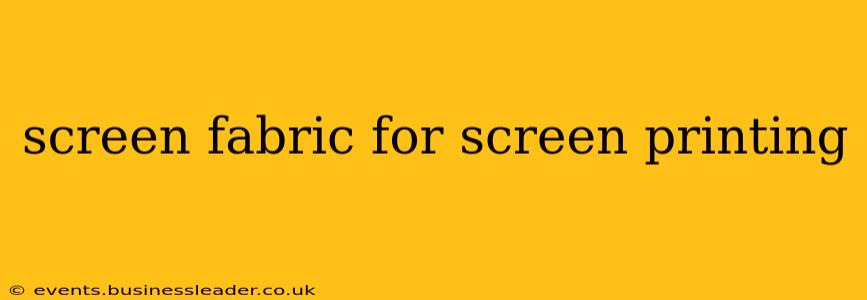Choosing the right screen fabric is crucial for successful screen printing. The fabric's mesh count, material, and overall quality directly impact the print's detail, durability, and the efficiency of your printing process. This guide will delve into the nuances of screen fabric selection, helping you make informed decisions to achieve professional-quality results.
What is Screen Fabric and Why Does it Matter?
Screen fabric, also known as mesh, forms the foundation of your screen printing stencil. It's stretched taut over a frame, and the image is created by blocking certain areas of the mesh, allowing ink to pass through the open areas onto the garment or substrate. The fabric's properties dictate several key aspects of the printing process:
- Ink Deposit: The mesh count influences the thickness and detail of the ink deposit.
- Image Sharpness: Finer meshes yield sharper images, while coarser meshes are better for bolder designs.
- Durability: Certain fabrics are more resistant to wear and tear, extending the lifespan of your screens.
- Printing Speed: The fabric's properties can impact the speed and efficiency of the printing process.
What are the Different Types of Screen Fabrics?
Screen fabrics are primarily categorized by their material and mesh count.
Materials:
- Polyester: This is the most common material, offering a good balance of strength, durability, and cost-effectiveness. It's suitable for a wide range of printing applications.
- Nylon: Nylon fabrics are known for their exceptional strength and durability, making them ideal for high-volume printing or applications requiring long-lasting screens. However, they are typically more expensive.
- Stainless Steel: Used for extreme applications, stainless steel screens provide exceptional durability and are resistant to harsh chemicals. These are often used for industrial printing.
Mesh Count:
The mesh count refers to the number of threads per linear inch (TPI). A higher mesh count means finer threads and smaller openings, leading to finer detail in the print. Lower mesh counts are suitable for bold designs and less detailed images. The choice depends on your project’s requirements:
- Low Mesh Count (60-80 TPI): Ideal for large, bold designs and plastisol inks with high viscosity.
- Medium Mesh Count (110-156 TPI): Versatile for a wide range of applications, offering a good balance of detail and ink flow. Suitable for water-based and plastisol inks.
- High Mesh Count (190-300 TPI): Best suited for fine detail work, delicate designs, and low-viscosity inks. Often used for photographic reproductions.
What Mesh Count Should I Use for Different Inks?
The type of ink you're using significantly impacts the ideal mesh count.
- Plastisol Inks: Typically require lower to medium mesh counts (80-156 TPI) due to their higher viscosity.
- Water-Based Inks: Often benefit from medium to high mesh counts (110-200 TPI) as they are thinner.
- Discharge Inks: Typically need medium to high mesh counts (110-190 TPI) for optimal results.
What is the Best Screen Fabric for Beginners?
For beginners, a polyester screen with a medium mesh count (around 110-156 TPI) is an excellent starting point. This provides a balance of print quality, durability, and ease of use.
How Do I Choose the Right Screen Fabric for My Project?
Consider the following factors:
- Design complexity: Fine details require high mesh counts, while bold designs work well with lower counts.
- Ink type: Different inks have varying viscosities and require appropriate mesh counts.
- Substrate: The material you're printing on can also influence mesh selection.
- Printing volume: If you're planning high-volume printing, invest in a more durable fabric like nylon.
What are the Differences Between Monofilament and Multifilament Screens?
- Monofilament: Made from a single thread, these screens provide excellent detail and sharpness but are less durable.
- Multifilament: Constructed from multiple threads braided together, these offer superior durability but may slightly reduce print sharpness.
Where Can I Buy Screen Printing Fabrics?
Screen printing fabrics are widely available from various online and brick-and-mortar suppliers specializing in screen printing supplies.
By carefully considering these factors, you can select the appropriate screen fabric to achieve consistent, high-quality results in your screen printing projects. Remember that experimentation is key to finding the perfect fabric for your specific needs and preferences.
